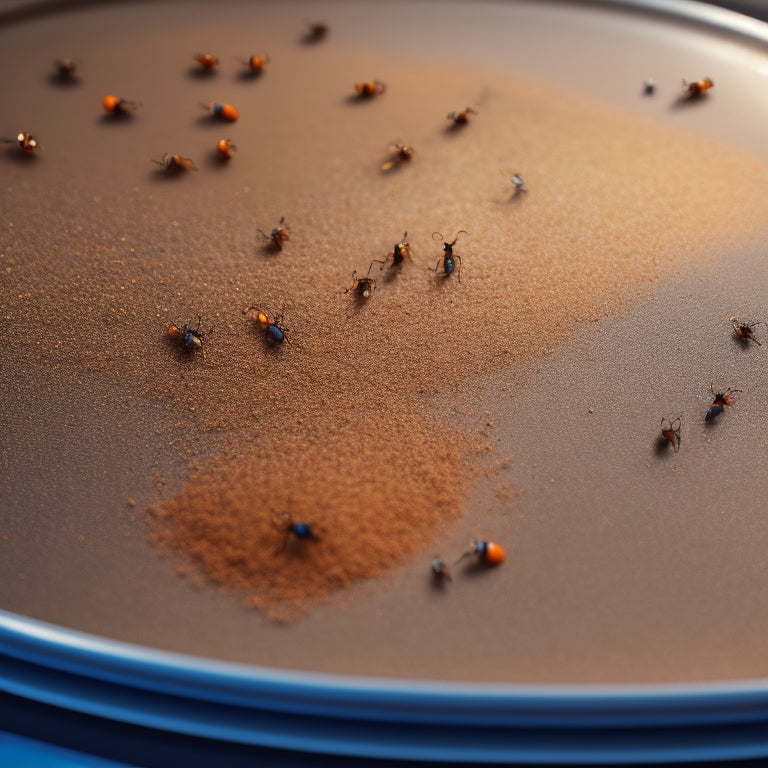
Ants Infest Sugar: Restaurant Inspections Reveal Hazards
Share
Restaurant inspections have uncovered a concerning trend: ants infesting sugar containers, compromising food safety and risking foodborne illness. Ant infestations pose a significant threat to food contamination, with ants found on countertops, near food prep areas, and in sugar containers. Proper storage, handling, and disposal of food waste are essential to prevent infestations. Inspectors identify violations compromising food safety, and restaurants must prioritize compliance with food safety regulations to prevent hazards. By addressing hazardous violations, restaurants can reduce the risk of foodborne illnesses and maintain a clean and safe environment; understanding the root causes of these violations is critical to preventing future infestations.
Key Takeaways
• Ant infestations in restaurants pose a significant threat to food contamination, compromising consumer safety and risking foodborne illness.
• Ants found in sugar containers, on countertops, and near food prep areas indicate poor storage, handling, and disposal of food waste.
• Restaurants must prioritize compliance with food safety regulations, adhering to temperature requirements and storage guidelines to prevent infestations.
• Effective pest control measures, including proper storage, labeling, cleaning schedules, and pest control, are essential to prevent future infestations.
• Immediate corrective actions, staff training on food safety and sanitation, and maintaining a clean environment can reduce the risk of foodborne illnesses.
The Inspection Process Uncovered
The Pennsylvania Department of Agriculture's pivotal inspection reporting system serves as an essential tool for ensuring compliance with food safety regulations in restaurants and food establishments. Through this system, inspectors identify violations that can compromise food safety, and subsequently recommend corrective actions to rectify these issues.
The inspection process is risk-based, focusing on establishments that pose a higher risk to public health. During inspections, violations are identified, and restaurants are rated accordingly. Recommendations for improvement are provided, and follow-up inspections are conducted to verify compliance.
Hazardous Violations Exposed
During routine inspections, hazardous violations are frequently uncovered, compromising the safety of consumers and necessitating immediate corrective action to prevent the risk of foodborne illness. Ants infestations, for instance, pose a significant threat to food contamination.
Inspectors have found ants crawling on countertops, near food preparation areas, and even inside sugar containers. This alarming discovery highlights the importance for restaurants to maintain a clean and sanitized environment.
Food contamination can occur when ants come into contact with food, utensils, or equipment, potentially spreading harmful bacteria. To mitigate this risk, restaurants must guarantee proper storage, handling, and disposal of food waste, as well as maintain regular cleaning schedules to prevent ants from infesting their establishments.
Compliance Is Key
Restaurants and food establishments must prioritize compliance with food safety regulations to prevent hazardous violations, ensuring a safe and healthy environment for consumers.
Adhering to temperature requirements and storage guidelines is essential in preventing contamination and spoilage. Immediate corrective actions must be taken to address violations, such as improper food storage or inadequate handwashing facilities.
Training recommendations can also be provided to staff to ensure they understand the importance of food safety and sanitation. By implementing these measures, restaurants can maintain a clean and safe environment, reducing the risk of foodborne illnesses and ensuring customer satisfaction.
Compliance is key to preventing hazardous violations and maintaining a reputable food establishment.
Facility Inspection Findings
Inspectors uncover a multitude of infractions at various establishments, including ants infesting sugar, expired condiments, and inadequately stored raw meat, necessitating immediate corrective actions to prevent contamination and guarantee compliance with food safety regulations. These findings highlight the importance of adequate facility maintenance and pest control measures.
In several instances, inspectors discovered poor storage practices, inadequate labeling, and inadequate temperature control, which can lead to foodborne illnesses. To address these issues, inspectors provided recommendations for improvement, including proper storage and labeling of food, regular cleaning schedules, and installation of necessary equipment. Additionally, establishments were advised to implement effective pest control measures to prevent future infestations.
Hygiene and Sanitation Lapses
Inadequate handwashing facilities and a lack of knowledge regarding proper hand hygiene practices among food handlers contribute substantially to the risk of foodborne illnesses. This oversight can lead to the spread of bacteria, viruses, and pests, compromising food safety.
Ineffective pest control measures allow rodents and insects to infiltrate food storage areas, contaminating products and equipment. Improper food storage practices, such as storing food directly on the floor, exacerbate the risk of contamination.
To mitigate these risks, restaurants must prioritize handwashing facilities, pest control measures, and proper food storage techniques. By addressing these hygiene and sanitation lapses, establishments can greatly reduce the risk of foodborne illnesses and maintain a safe environment for consumers.
Frequently Asked Questions
What Happens to Restaurants With Repeated Violations?
In instances of persistent non-compliance, restaurants may face 'operational adjustments,' potentially leading to license revocation or fine imposition, highlighting the significance of proactive compliance measures to secure a safe and healthy dining environment.
Are All Food Establishments Inspected Equally Often?
Inspection frequencies vary based on risk assessment, with higher-risk establishments, such as those serving vulnerable populations, receiving more frequent inspections, while lower-risk establishments may receive less frequent inspections, potentially leading to unequal treatment.
Can Customers Request to See Inspection Reports?
Yes, customers can request to see inspection reports, promoting transparency and accountability in food establishments. Report access allows patrons to make informed decisions, ensuring a safer dining experience and encouraging establishments to maintain high standards of hygiene and sanitation.
How Often Do Inspectors Revisit Restaurants for Follow-Up?
Inspectors revisit restaurants for follow-up at varying frequencies, typically within 30-60 days, depending on the severity of violations, to guarantee compliance and verify corrective actions, with subsequent inspections scheduled as needed to maintain food safety standards.
Do Inspectors Provide Guidance on Correcting Violations?
Inspectors provide guidance on correcting violations by offering explanations for non-compliance, demonstrating empathy towards restaurateurs, and supplying detailed recommendations for corrective actions, ensuring a thorough understanding of necessary improvements to maintain food safety standards.
Related Posts
-

Stylish Space-Saving Bathroom Cabinet Ideas
Revamp your bathroom into a stylish yet functional retreat with clever space-saving cabinet ideas. Consider wall-moun...
-

Global Forum on Environmental Science & Solutions
The Global Forum on Environmental Science and Solutions is an essential platform for experts to convene, share knowle...
-

Organize Your Bathroom With Stylish Labels
Effortless bathroom organization begins with stylish labels that establish a sense of order, making it easy to find w...


